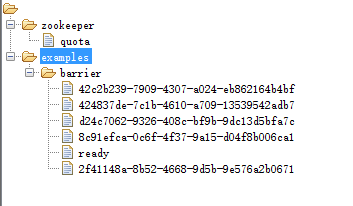分布式Barrier是这样一个类: 它会阻塞所有节点上的等待进程,知道某一个被满足, 然后所有的节点继续进行。
比如赛马比赛中, 等赛马陆续来到起跑线前。 一声令下,所有的赛马都飞奔而出。

1.栅栏Barrier
1.DistributedBarrier类说明
DistributedBarrier类实现了栅栏的功能。它的构造函数如下:
/*** @param client client* @param barrierPath path to use as the barrier*/public DistributedBarrier(CuratorFramework client, String barrierPath)
DistributedBarrier构造函数中barrierPath参数用来确定一个栅栏,只要barrierPath参数相同(路径相同)就是同一个栅栏。通常情况下栅栏的使用如下:
1.主导client设置一个栅栏
2.其他客户端就会调用waitOnBarrier()等待栅栏移除,程序处理线程阻塞
3.主导client移除栅栏,其他客户端的处理程序就会同时继续运行。
DistributedBarrier类的主要方法如下:
- setBarrier() - 设置栅栏
- waitOnBarrier() - 等待栅栏移除
- removeBarrier() - 移除栅栏
异常处理:DistributedBarrier会监控连接状态,当连接断掉时waitOnBarrier()方法会抛出异常。
2.编写示例程序
public class DistributedBarrierExample{private static final int QTY = 5;private static final String PATH = "/examples/barrier";public static void main(String[] args) throws Exception{CuratorFramework client = CuratorFrameworkFactory.newClient("127.0.0.1:2181", new ExponentialBackoffRetry(1000, 3));client.start();ExecutorService service = Executors.newFixedThreadPool(QTY);DistributedBarrier controlBarrier = new DistributedBarrier(client, PATH);controlBarrier.setBarrier();for (int i = 0; i < QTY; ++i){final DistributedBarrier barrier = new DistributedBarrier(client, PATH);final int index = i;Callable<Void> task = new Callable<Void>(){@Overridepublic Void call() throws Exception{Thread.sleep((long) (3 * Math.random()));System.out.println("Client #" + index + " 等待");barrier.waitOnBarrier();System.out.println("Client #" + index + " 开始");return null;}};service.submit(task);}Thread.sleep(1000 * 3);System.out.println("所有的Client都在等待");controlBarrier.removeBarrier();service.shutdown();service.awaitTermination(10, TimeUnit.MINUTES);client.close();System.out.println("OK!");}}
这个例子创建了controlBarrier来设置栅栏和移除栅栏。我们创建了5个线程,在此Barrier上等待。最后移除栅栏后所有的线程才继续执行。
如果你开始不设置栅栏,所有的线程就不会阻塞住。
3.示例程序运行结果
运行结果控制台:
Client #1 等待Client #2 等待Client #0 等待Client #4 等待Client #3 等待所有的Client都在等待Client #4 开始Client #2 开始Client #0 开始Client #3 开始Client #1 开始OK!
运行时查看Zookeeper节点信息如下:

2.双栅栏Double Barrier
双栅栏允许客户端在计算的开始和结束时同步。当足够的进程加入到双栅栏时,进程开始计算,当计算完成时,离开栅栏。双栅栏类是DistributedDoubleBarrier
1. DistributedDoubleBarrier类说明
DistributedDoubleBarrier类实现了双栅栏的功能。它的构造函数如下:
// client - the client// barrierPath - path to use// memberQty - the number of members in the barrierpublic DistributedDoubleBarrier(CuratorFramework client, String barrierPath, int memberQty)
memberQty是成员数量,当enter方法被调用时,成员被阻塞,直到所有的成员都调用了enter。当leave方法被调用时,它也阻塞调用线程,知道所有的成员都调用了leave。
就像百米赛跑比赛, 发令枪响, 所有的运动员开始跑,等所有的运动员跑过终点线,比赛才结束。
注意:参数memberQty的值只是一个阈值,而不是一个限制值。当等待栅栏的数量大于或等于这个值栅栏就会打开!
与栅栏(DistributedBarrier)一样,双栅栏的barrierPath参数也是用来确定是否是同一个栅栏的,双栅栏的使用情况如下:
1.从多个客户端在同一个路径上创建双栅栏(DistributedDoubleBarrier),然后调用enter()方法,等待栅栏数量达到memberQty时就可以进入栅栏。
2.栅栏数量达到memberQty,多个客户端同时停止阻塞继续运行,直到执行leave()方法,等待memberQty个数量的栅栏同时阻塞到leave()方法中。
3.memberQty个数量的栅栏同时阻塞到leave()方法中,多个客户端的leave()方法停止阻塞,继续运行。
DistributedDoubleBarrier类的主要方法如下:
- enter()、enter(long maxWait, TimeUnit unit) - 等待同时进入栅栏
- leave()、leave(long maxWait, TimeUnit unit) - 等待同时离开栅栏
异常处理:DistributedDoubleBarrier会监控连接状态,当连接断掉时enter()和leave方法会抛出异常。
2.编写示例程序
public class DistributedBarrierDoubleExample{private static final int QTY = 5;private static final String PATH = "/examples/barrier";public static void main(String[] args) throws Exception{CuratorFramework client = CuratorFrameworkFactory.newClient("127.0.0.1:2181", new ExponentialBackoffRetry(1000, 3));client.start();ExecutorService service = Executors.newFixedThreadPool(QTY);for (int i = 0; i < (QTY + 2); ++i){final DistributedDoubleBarrier barrier = new DistributedDoubleBarrier(client, PATH, QTY);final int index = i;Callable<Void> task = new Callable<Void>(){@Overridepublic Void call() throws Exception{Thread.sleep((long) (3 * Math.random()));System.out.println("Client #" + index + " 等待");if(false == barrier.enter(5, TimeUnit.SECONDS)){System.out.println("Client #" + index + " 等待超时!");return null;}System.out.println("Client #" + index + " 进入");Thread.sleep((long) (3000 * Math.random()));barrier.leave();System.out.println("Client #" + index + " 结束");return null;}};service.submit(task);}service.shutdown();service.awaitTermination(10, TimeUnit.MINUTES);client.close();System.out.println("OK!");}}
注意:创建双栅栏的数量为:(QTY + 2),而创建双栅栏的参数为:new DistributedDoubleBarrier(client, PATH, QTY),当等待栅栏的数量大于或等于这个值(QTY)栅栏就会打开!
3.示例程序运行结果
运行结果控制台:
Client #0 等待Client #2 等待Client #3 等待Client #4 等待Client #1 等待Client #4 进入Client #2 进入Client #0 进入Client #1 进入Client #3 进入Client #4 结束Client #5 等待Client #2 结束Client #3 结束Client #6 等待Client #0 结束Client #1 结束Client #5 等待超时!Client #6 等待超时!OK!
运行时查看Zookeeper节点信息如下:
